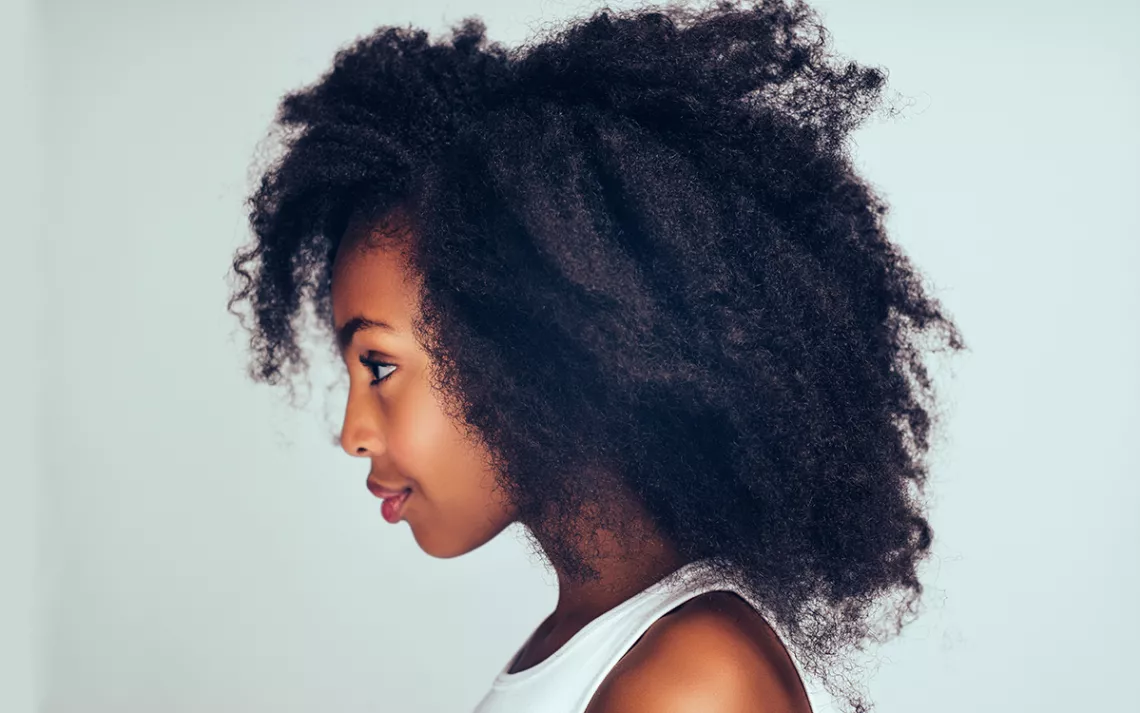The Hazardous Chemicals Lurking in Black Hair Care Products
Here’s what to avoid in “natural” labels—and how protect black hair
Black hair care is a journey.
And increasingly, black women are choosing to embrace the aesthetic of our naturally textured hair rather than choosing to chemically straighten, relax, or otherwise alter our hair to conform to Eurocentric beauty standards. In 2018, many black models and actresses have sported elegant, protective styles that proudly distinguish Afrocentric lineage. If a beauty company wants to stay competitive and not get dragged on social media, ad campaigns will (more often than in previous decades, anyway) feature brown-skinned models with hair and attributes that don’t exclusively conform to arbitrary colonial beauty standards. This latest hair renaissance represents a reclaiming of our socio-cultural agency—and of our health and environmental awareness, as we demand products that cater specifically to our bodies.
At the same time, hair product companies are taking advantage of the natural hair bandwagon—leaving consumers to navigate a maze of murky claims and persuasive branding. “‘Natural’ is just marketing in the hair industry,” says Ruth Brooks, owner of Organic Beauty Salon in New York City and founder of Harlem’s first organic salon. Brooks, who plans to launch a beauty school this winter dedicated to licensing natural hair stylists, was shocked to learn about the rampant inclusion of hazardous ingredients in black hair products. “There’s no incentive to regulate the cosmetics industry. [Black hair] products specifically are a slurry of industrial waste, which lowers the price to be widely sold.” At her salon, Brooks emphasizes to her clients how critical it is to read ingredient labels, and to be wary of toxic chemicals that manufacturers are sneaking into “natural” products made for black hair.
From a business standpoint, there’s certainly incentive to capitalize on the demand for natural black hair care products: In 2016, black consumers spent over $2 billion on the products. Yet a study by the Environmental Working Group found that over 70 percent of products marketed for black hair contain dangerous ingredients, compared with 40 percent of hair products that are made for the “general public.”
Let that sink in for a moment.
The study of more than 1,100 hair products marketed toward black consumers revealed a shocking bias in the products’ chemical composition. Less than one in four products tested “low hazard” for the inclusion of dangerous ingredients, with most containing toxic chemicals that can potentially cause cancer or developmental and reproductive damage, disrupt hormones, and trigger other adverse health effects. Toxic ingredients such as lye (found in relaxers) and formaldehyde (found in keratin straightening treatments and Brazilian blowouts) are still commonly used in black hair salons.
Largely toothless federal regulation has made it easy for the cosmetics industry to get away with using highly toxic ingredients. The only government oversight comes from the Federal Food, Drug, and Cosmetic Act of 1938 and the Fair Packaging and Labeling Act of 1967, which are supposed to safeguard the American people from misbranding. Yet neither of these acts require cosmetic products to undergo FDA approval before hitting the market. Terms like natural and organic are highly subjective scientifically, and clever wording allows companies to slip in all kinds of dangerous chemicals. “There are a lot of chemicals in the periodic table that are technically ‘natural,’” Brooks points out. “Ammonia is natural. Alcohol is natural. Companies will put a little bit of aloe or olive oil into a product and call it organic—but all the bad stuff is still there too.” Case in point: Relaxers, by far the most hazardous product tested, are now branded by cosmetic companies as safe if they contain no lye, yet the EWG analysis found that many companies merely replaced the lye with calcium hydroxide, a caustic irritant. While hashtags and social media campaigns within the black community are helping to raise awareness of harmful products, the companies themselves face no threat of litigation.
Some efforts persist on Capitol Hill to finally regulate the cosmetics industry. In May 2017, Senators Dianne Feinstein (D-California) and Susan Collins (R-Maine) introduced the Personal Care Product Safety Act, which would require cosmetic companies to submit detailed lists of ingredients for every product and risk being denied if the ingredients don’t meet FDA standards. But the square wheels of justice turn slowly, and there’s been no movement with this bill since its introduction over a year ago. Which means black women are left to educate ourselves on the healthiest choices to make for our bodies.
Having gone through my own “big chop” (that’s when a person cuts off all their chemically treated hair at once) in 2013, I can attest that natural hair maintenance definitely requires re-education. Like many black women, I grew up sitting edgily by the stove once or twice a week while my mother, grandmother, or aunt carefully dragged a searing hotcomb through my very resistant 4c hair (that’s a common term for black hair that is naturally more wiry, coarse, or tightly curled than others). Thanks to arbitrary beauty standards that condemn natural African or African American hair as “bad hair,” generations of black women have felt compelled by society to make our hair do what it was never meant to do: obey the laws of gravity.
The current natural hair movement really comes down to choice. There’s nothing wrong with enjoying straight hair; there is room for all manner of styles in a movement that’s centered on self-love. By reshaping our own narratives of who gets to determine what “good hair” is (read: no one but ourselves), we are exercising our right to embrace a concept of beauty that enhances our personal agency and fosters pride in our culture. Thanks to the trailblazing guidance of natural black hair blogs like Afrobella, CurrlyNikki, Black Girl Long Hair, and Naptural85, it’s become easier for black women to share knowledge, tips, warnings, struggles, and joy along the communal journey toward rediscovery of our hair.
In that spirit of sharing, we’ve compiled two lists to help decipher ingredients in hair care products. The former contains essential oils that are particularly beneficial for black hair, and the latter is a roundup of common hazardous chemicals to avoid. It’s hard to find any brands that wholly abstain from sneaking in hazardous ingredients; however, Taliah Waajid, Jane Carter, Cantu, SheaMoisture, As I Am, and 3 Sisters of Nature are all natural hair brands that promote organic, cruelty-free products with few or no harmful chemicals.
When choosing any product, follow the five-ingredient rule: Pay careful attention to the first five ingredients on the list, as they make up over 90 percent of what’s in a product. Keep in mind, not all oils work for everyone, and part of a hair journey involves exploring what works through trial and error.
Healthy Hair Ingredients
- Aloe vera (contains proteolytic enzymes good for healing scalp problems and stimulating hair growth)
- Avocado (dermatological benefits for scalp, with vitamins A, D, and E; effectively lubricates hair strand, preventing breakage)
- Shea butter (a hydrating emollient; protects the hair strand)
- Castor oil (antifungal; cleans the scalp, clearing follicles and promoting hair growth)
- Coconut oil (a hydrating emollient that seals moisture around the hair follicle)
- Extra virgin olive oil (a hydrating emollient and moisturizer, effective at softening hair)
- Grapeseed (lightweight conditioner and moisturizer; mildly astringent, thus effective at fighting dandruff; easily absorbs into hair and scalp and is packed with healthy fatty acids)
- Honey (humectant and antifungal)
- Jojoba (hair strengthener, rich in vitamins C, E, and B; dermatological benefits for repairing scalp dryness and inflammation)
Hazardous Ingredients to Avoid
- “Fragrance” or “parfum” (this is a widely used smoke screen in the cosmetics industry, denoting a vague mixture of unknown chemicals)
- Calcium hydroxide
- Formaldehyde or methylene glycol (formaldehyde is also released by DMDM hydantoin, diazolidinyl urea, and imidazolididinyl urea)
- Lead acetate (common in hair dyes)
- Methylisothiazolinone
- Parabens (propylparaben, butylparaben, or methylparaben)
- Petroletum
- Retyinal palmitate
- Specific alcohols:
- Alcohol denat, ethanol, propanol, isopropyl, propyl, SD alcohol #4 (also known by stylists as wood alcohol)
- Sulfates
 The Magazine of The Sierra Club
The Magazine of The Sierra Club




